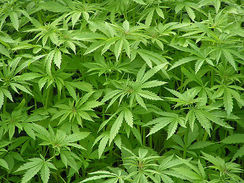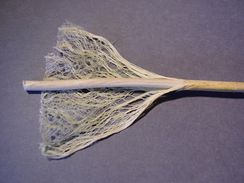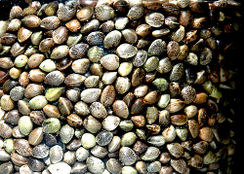Hemp: Difference between revisions
No edit summary |
No edit summary |
||
| Line 30: | Line 30: | ||
Soil that produces high yields of corn tends to be the most suitable soil for hemp.[http://www.madehow.com/Volume-6/Industrial-Hemp.html] | Soil that produces high yields of corn tends to be the most suitable soil for hemp.[http://www.madehow.com/Volume-6/Industrial-Hemp.html] | ||
The soil must be well drained, rich in nitrogen, and non-acidic.[http://www.madehow.com/Volume-6/Industrial-Hemp.html] | The soil must be well drained, rich in nitrogen, and non-acidic.[http://www.madehow.com/Volume-6/Industrial-Hemp.html] | ||
Soil temperatures must reach a minimum of 42-46°F or 5.5-7.7°C before seeds can be planted.[http://www.madehow.com/Volume-6/Industrial-Hemp.html] | Soil temperatures must reach a minimum of 42-46°F or 5.5-7.7°C before seeds can be planted.[http://www.madehow.com/Volume-6/Industrial-Hemp.html] | ||
| Line 44: | Line 42: | ||
The crop is ready for harvesting high quality fiber when the plants begin to shed pollen, in mid-August for North America.[http://www.madehow.com/Volume-6/Industrial-Hemp.html] | The crop is ready for harvesting high quality fiber when the plants begin to shed pollen, in mid-August for North America.[http://www.madehow.com/Volume-6/Industrial-Hemp.html] | ||
Harvesting for seed occurs four to six weeks later.[http://www.madehow.com/Volume-6/Industrial-Hemp.html] | Harvesting for seed occurs four to six weeks later.[http://www.madehow.com/Volume-6/Industrial-Hemp.html] | ||
Fiber hemp is normally ready to harvest in 70-90 days after seeding.[http://www.madehow.com/Volume-6/Industrial-Hemp.html] | Fiber hemp is normally ready to harvest in 70-90 days after seeding.[http://www.madehow.com/Volume-6/Industrial-Hemp.html] | ||
==== Harvest equipment ==== | ==== Harvest equipment ==== | ||
Combines are used for harvesting and special machines with rows of independent teeth and a chopper is used for harvesting. To harvest hemp for textiles, specialized cutting equipment is used. [http://www.madehow.com/Volume-6/Industrial-Hemp.html] | Combines are used for harvesting and special machines with rows of independent teeth and a chopper is used for harvesting. To harvest hemp for textiles, specialized cutting equipment is used. [http://www.madehow.com/Volume-6/Industrial-Hemp.html] | ||
=== Processing === | === Processing === | ||
Revision as of 12:43, 29 December 2019


Hemp has a variety of uses, not just for rope and fabric, but also as a readily renewable resource for making paper, construction materials, high protein food, and safe, clean fuel.
Uses
Hemp can be grown nearly anywhere. It grows very rapidly and has many uses:
- Rope. Hemp fiber is very strong.
- Textiles. Hemp fiber can be woven into a material like light cotton (suitable for T-shirts etc.) or a thick canvas material suitable for bags, warm blankets. See the page on spinning and weaving for instructions on what to do with it once harvested.
- Hempcrete (also see Wikipedia page: hempcrete)
- paper
- a small percentage of hemp was used in what appears to be a composite - rather than bioplastic - car body (70% fiber, of which fiber 10% was hemp, and 30% binder) - [1]
- replacement for plastics (example: hemp fiber, biocomposites, etc.)
- Food - The seeds are extremely nutritious.
- animal feed
- body care (soaps - from hemp oil and lye)
- various chemicals
- fuels (hemp oil / biodiesel/ cellulosic ethanol)
Cultivation, harvest, and processing
Cultivation
Hemp is an annual plant that grows from seed. It can be cultivated in a range of soils and in green houses.
Beneficial conditions for cultivation
Soil that produces high yields of corn tends to be the most suitable soil for hemp.[2]
The soil must be well drained, rich in nitrogen, and non-acidic.[3]
Soil temperatures must reach a minimum of 42-46°F or 5.5-7.7°C before seeds can be planted.[4]
Hemp prefers a mild climate, humid atmosphere, and a rainfall of at least 25-30 in or 64-76 cm per year.[5]
Harvesting
Harvest timing
The crop is ready for harvesting high quality fiber when the plants begin to shed pollen, in mid-August for North America.[6]
Harvesting for seed occurs four to six weeks later.[7]
Fiber hemp is normally ready to harvest in 70-90 days after seeding.[8]
Harvest equipment
Combines are used for harvesting and special machines with rows of independent teeth and a chopper is used for harvesting. To harvest hemp for textiles, specialized cutting equipment is used. [9]
Processing
Links
- Overview publication - [10]
- North American Industrial Hemp Council
- Appropedia: Hemp
- OMAFRA: Growing Industrial Hemp in Ontario
Industry Standards
- Largest hemp processing plant in America - [11]




